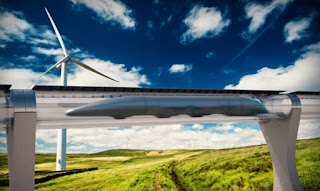Hyperloop:760mph trains-quality future
Hyperloop is a upcoming feature of
passenger and freight transportation that propels a pod-like vehicle through a
near-vacuum tube at airline speeds. The pods accelerate to cruising speed
gradually using a linear electric motor and glide above their track using passive
magnetic levitation or air bearings. The tubes can go above ground on columns
or underground, eliminating the dangers of grade crossings. It is hoped that
the system will be highly energy-efficient, quiet and autonomous. Hyperloop
Transportation(HTT) Technologies has revealed how its Elon Musk-inspired bullet
train will levitate on a magnetic field as it blasts between stations at the
speed of sound. The train will use a technology called passive magnetic
levitation which its creators claim is more efficient and safer than the
levitation system used by Maglev trains in Japan.
Where Maglev trains
require many power stations to be installed along the side of the track, each
feeding electricity to copper cables in the track, which become an
electromagnet once charged, the Hypertrophy system has a passive magnet on each
train carriage and an aluminium track containing loops of wire. This setup is
more like a pair of regular magnets, rather than an electromagnet which
requires a constant supply of electricity to work.
Bibop Gresta, chief
operations officer of Hyperloop Transport Technologies (HTT), explained how
this system is better than Meglev. "Utilising a passive levitation system
will eliminate the need for power stations along the Hyperloop track, which
makes this system the most suitable for the application and will keep
construction costs low."
Criticism
Criticism of Musk’s Hyperloop comes from doubts about the technology and the
project's economics. In Musk’s proposal, he estimates the total cost of the
project to be roughly $6 billion. Many believe the expected costs are
drastically underestimated with the entire project forecasted
closer to $100 billion. Despite its optimistic construction costs, the proposed
individual fares of $20 per person have also been criticized as impossible.
Finally, compared to the California High Speed Rail estimated costs of $68
billion, the Hyperloop’s proposed price tag of $6 billion is dubious.
Costs aside, the
technical aspects of the Hyperloop have raised doubts. Speeds over 700 mph
would surpass any commercial mode of transportation currently available. These
extreme speeds would subject passengers to uncomfortable and frightening forces
rendering the system unrideable. What's more, the Hyperloop is capable of carrying just 3,360 passengers each
hour (if they can withstand the g-forces). Comparatively, a freeway lane can
carry 2,000 cars per hour, a subway transports 36,000 passengers per hour, and
the California High Speed Rail is estimated to carry 12,000 passengers per
hour. Despite any apparent doubts and pitfalls, though, Elon Musk’s history of
innovation adds credibility to the question of whether or not Hyperloop can
succeed.



Comments